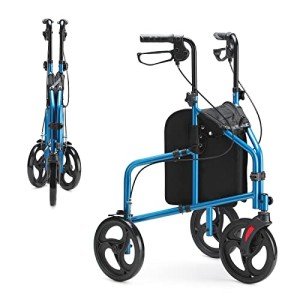
9
MayWhat's Holding Back What's Holding Back The Adjustable Walker Industry?

Understanding Adjustable Walkers: A Comprehensive Guide
Adjustable walkers are essential mobility aids designed to supply stability and support to people with mobility difficulties. They improve independence, safety, and confidence for people recovering from surgical treatment, handling persistent conditions, or facing age-related mobility issues. This post digs into the features, types, benefits, and typical FAQs connected to adjustable walkers, providing insights for potential users and caretakers.
What is an Adjustable Walker?
An adjustable walker is a mobility aid that normally includes a Lightweight 3-Wheeled Tri Walker: Comfort & Convenience frame with 4 legs, equipped with handgrips for support. It can be adapted to accommodate different heights, guaranteeing users attain a comfy wrist position while supporting their weight. Adjustable walkers can be found in various styles, each customized to particular requirements.
Secret Features of Adjustable Walkers
- Height Adjustment: Most adjustable walkers have telescoping legs, allowing users to easily customize the height to suit their stature.
- Weight Capacity: Different designs accommodate varying weight limitations, catering to a broad group.
- Foldability: Many walkers are collapsible, making them simple to shop and transport.
- Wheels vs. No Wheels: Some walkers feature wheels on the front legs, while others have a basic style without wheels, promoting stability.
- Extra Accessories: Walkers can often be equipped with trays, baskets, or cup holders for added benefit.
| Feature | Description |
|---|---|
| Height Adjustment | Telescoping legs for customized height settings |
| Weight Capacity | Varies by model, supporting various body weights |
| Foldability | Collapsible style for easy transportation and storage |
| Wheels | Available in both wheeled and non-wheeled choices |
| Additional Accessories | Trays, baskets, and cup holders for user benefit |
Types of Adjustable Walkers
- Standard Walkers: Traditional models with four legs. Best for those seeking optimum stability.
- Wheeled Walkers (Rollators): Walkers with 2 or more wheels, enabling much easier maneuvering.
- Hemi Walkers: Designed for people with the use of one hand, featuring a single arm support for added stability.
- Child Walkers: Specifically created for babies learning to walk, promoting safety and assistance during early mobility.
Benefits of Using Adjustable Walkers
Boost Independence
- Enhanced Mobility: Adjustable walkers permit users to navigate their environments with more ease and confidence, promoting a sense of self-reliance.
- Availability: With the right walker, users can preserve their lifestyle and participate in activities they enjoy without assistance.
Injury Prevention
- Stability and Support:Handicap Walker users can preserve much better balance and Walking Frame avoid falls, which are especially vital for seniors and individuals recuperating from surgical treatment.
- Minimized Strain: Proper use of a walker can ease stress on joints and muscles, lessening the threat of injury throughout My Mobility Scooters.
Comfort and Customization
- Adjustable Settings: Walkers can be tailored to each user's height and comfort, offering a more individualized experience.
- Extra Features: Options for devices assist in accommodating individual requirements, enabling users to bring products while moving.
Costs and Considerations
The price of adjustable walkers varies depending on features, materials, and brand. Here's a summary of the typical costs related to various types:
| Walker Type | Average Cost |
|---|---|
| Standard Walkers | ₤ 50 - ₤ 100 |
| Wheeled Walkers | ₤ 75 - ₤ 200 |
| Hemi Walkers | ₤ 60 - ₤ 150 |
| Baby Walkers | ₤ 30 - ₤ 70 |
Often Asked Questions (FAQs)
1. How do I know which adjustable walker is best for me?
The best adjustable walker depends upon your particular requirements, physical condition, and environment. It's vital to consult a health care professional to figure out the most appropriate type.
2. Can I adjust the height of any walker?
Most adjustable walkers include a height-adjustment system. However, not all walkers are adjustable. It's important to analyze item specs before purchasing.
3. Are wheeled walkers safe to use?
Yes, wheeled walkers (or rollators) are safe for users who can browse them properly. They frequently consist of brakes for included safety when stationary.
4. How do I take care of my adjustable walker?
Regular care involves cleaning the walker with mild soap and water, examining for wear on grips and wheels, and making sure systems operate smoothly.
5. Can I take my adjustable walker on public transport?
Yes, many adjustable walkers are Foldable Rollator Walker with Seat & 8” Wheels and developed for simple transport. Nevertheless, it's recommended to examine the specific guidelines of the transportation service.
6. Do I require help to use an adjustable walker?
Lots of users can operate adjustable walkers separately, specifically when effectively fitted to their height. Nevertheless, those with extreme mobility concerns may benefit from assistance.
Adjustable walkers are important tools for boosting mobility, self-reliance, and safety. With a variety of designs and designs, individuals can find a walker tailored to their needs. Caregivers and users alike ought to appreciate the importance of seeking advice from healthcare professionals to make informed choices relating to mobility aids. Comprehending the features, benefits, and factors to consider of adjustable walkers empowers people to keep an active way of life, enhancing their quality of life regardless of mobility difficulties.
Reviews